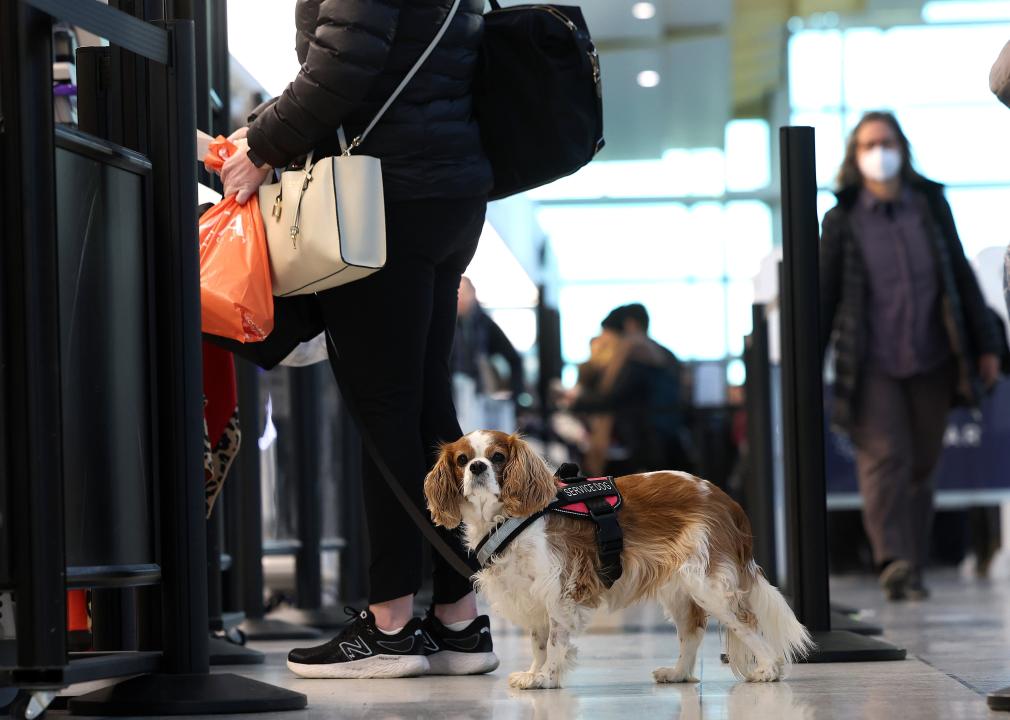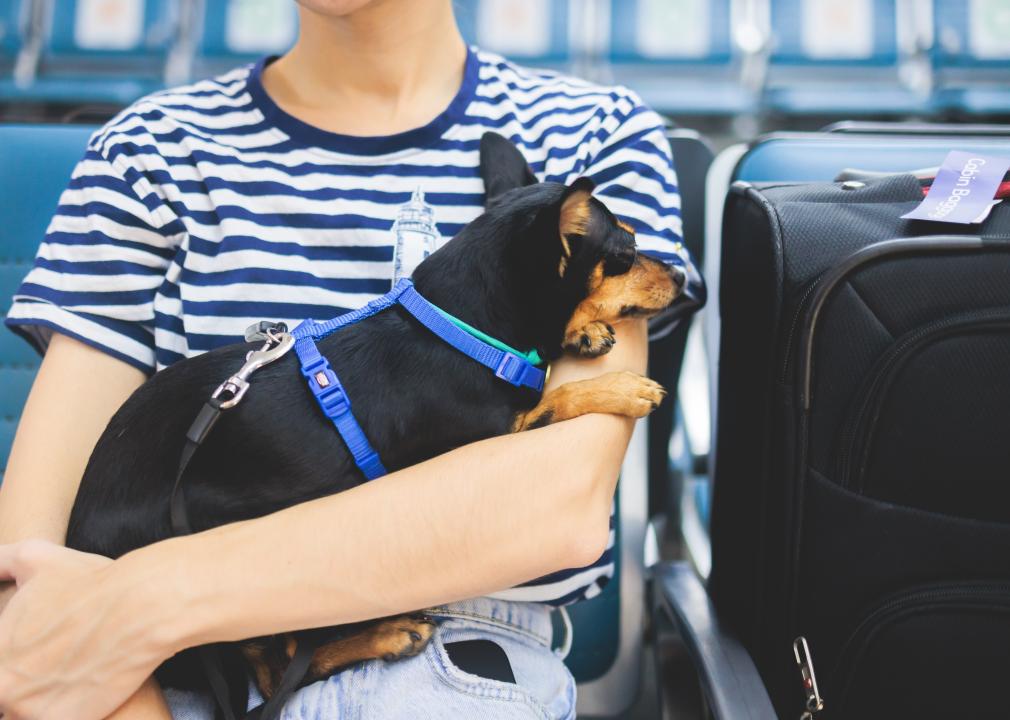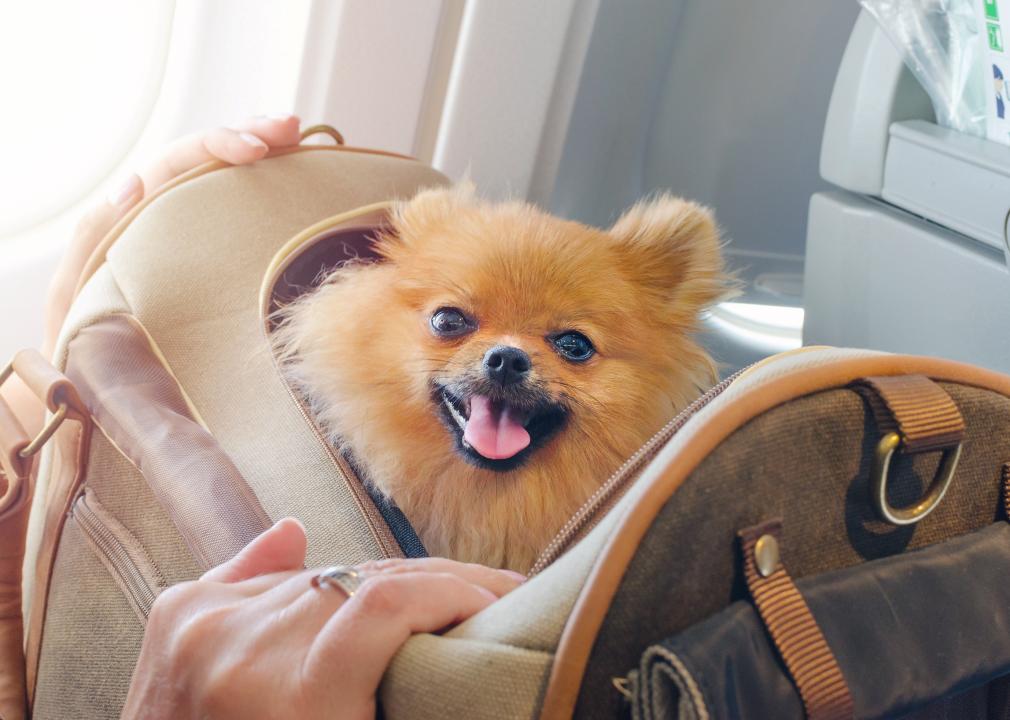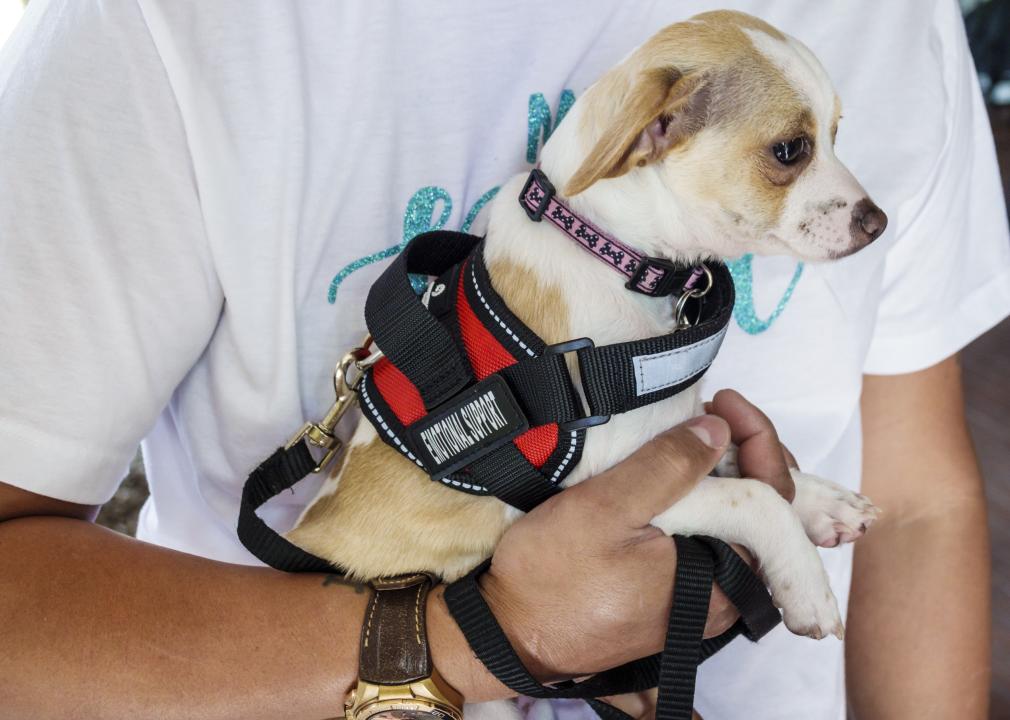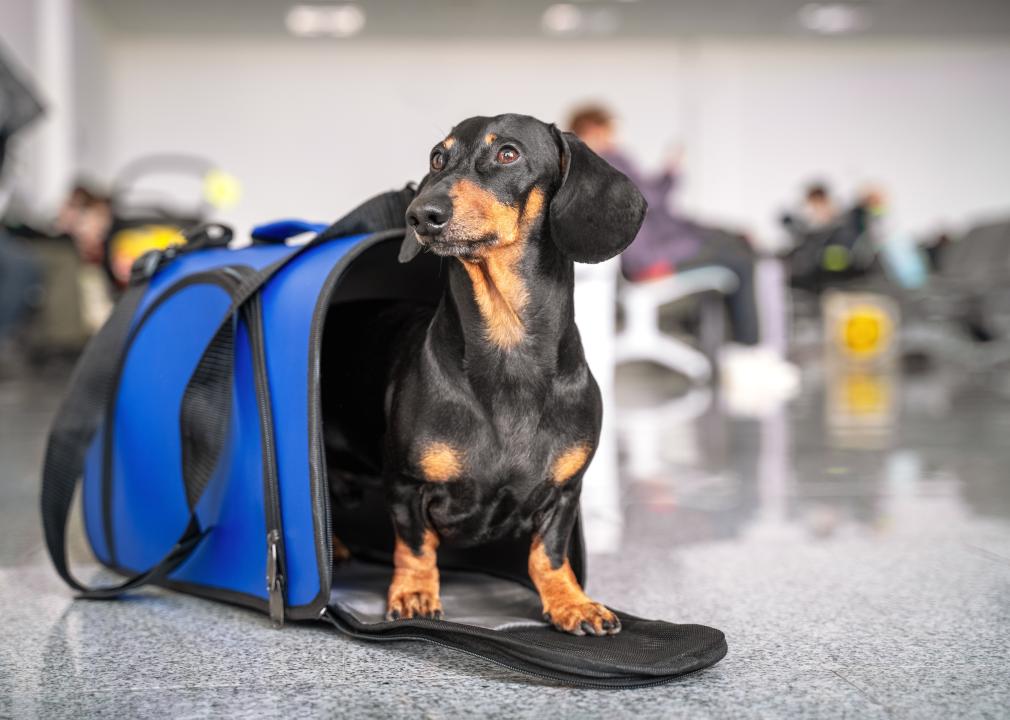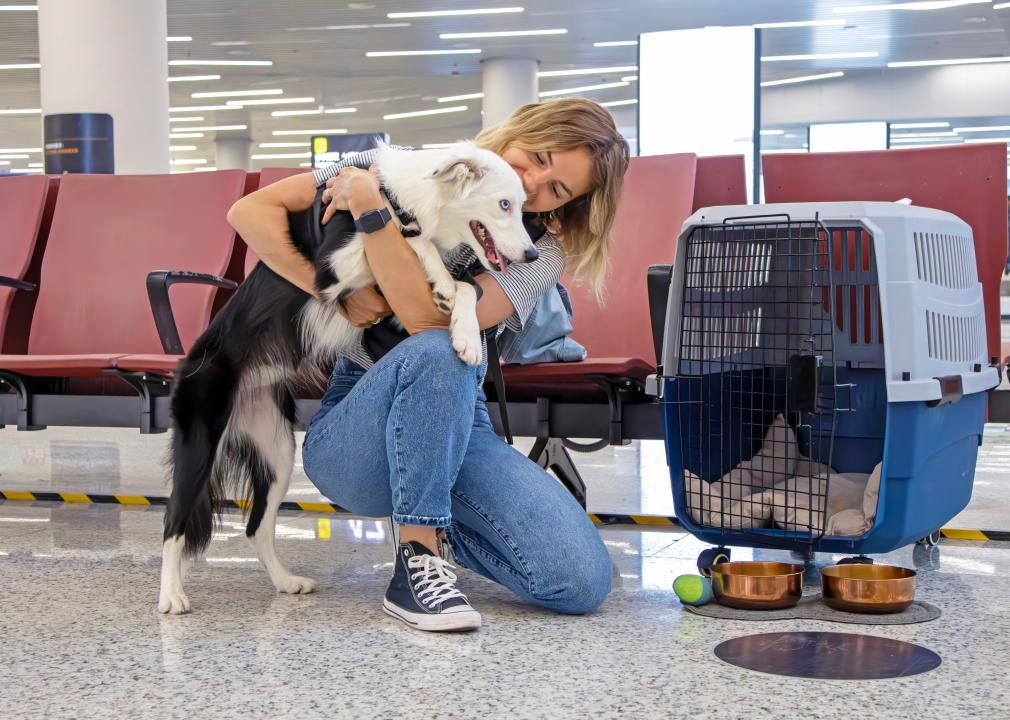Which airline is the best to travel with an emotional support animal? See how policies vary.
Kevin Dietsch // Getty Images
Which airline is the best to travel with an emotional support animal? See how policies vary.
A dog goes through a security checkpoint at Ronald Reagan Washington National Airport.
When will we see an emotional support pig on an airplane again? When pigs fly, according to the policies of major airlines ever since the Department of Transportation declassified emotional support animals as service animals.
The change, issued on Dec. 2, 2020, limited the definition of a service animal to dogs specially trained to perform a task or work for a person with a disability. This removed the requirement for airlines to permit animals aboard that were pre-registered as ESAs, holding them instead to the same policies, restrictions, and fees as other pets.
In years past, claims of emotional support horses, monkeys, and ducks seemed to undermine the legitimacy of ESAs in the eyes of the public, leading more than 20 states to enact new laws in an effort to curb passing off emotional support animals as service dogs by 2019. Airlines followed suit, leaving pet owners contemplating travel to wonder, “What now?”
To analyze which major airlines are the most ESA-friendly, Pettable reviewed and compared the major airlines’ policies regarding pet travel in the cabin. Major airlines are defined as those with the highest passenger-mile volume over the past year, per the Bureau of Transportation Statistics.
Despite the skepticism, ESAs are thought to be life-changing for their owners. Pet owners display lower blood pressure in high-stress situations, are less likely to be depressed, and even live longer. In a first-of-its-kind longitudinal study published in 2022, Dr. Janet Hoy-Gerlach and her colleagues at the University of Toledo found that the 11 participants—all of whom dealt with serious mental health issues such as PTSD and bipolar disorder—reported improvements in their levels of anxiety, depression, and loneliness after a year with ESAs.
Benefits aside, the DOT’s guidelines continue to be in effect, making it challenging for ESA owners to fly. Pet parents should make travel arrangements early and confirm the space for their pets, as most only take a certain number of pet carriers on a first-come, first-served basis. Major airlines differ in which types of pets are allowed aboard. Kennel sizes also vary, which may limit ESAs that can fly in the cabin.
To help guide travel decisions, here’s a breakdown of policies among major airlines.
![]()
Tsuguliev // Shutterstock
United Airlines
Small dog sitting in the hands of owner in an airport.
United Airlines considers emotional support and therapy animals to be pets, offering no additional accommodations for ESAs from its pet policy. The airline allows cats and dogs that can fit in a carrier that slides under a cabin seat and up to two pets per passenger at $150 each way. However, a second pet requires purchasing another seat on the flight beside yours so owners can care for both pets simultaneously.
United also does not allow pets to fly to, from, and even through some countries and states, like the United Kingdom or Hawaiʻi. There are even some cases where you could bring pets to a country but not on the way back, such as a trip from Guam to Tokyo. It’s important to ensure your destination allows pets so no one gets stranded.
Pets must stay in their carrier under the seat ahead of you throughout the entire flight. Unlike other airlines, United does not have breed restrictions for brachycephalic—short-nosed cats and dogs—which face more health risks during air travel. ESAs that do not meet the cabin’s size restrictions are out of luck as well since United restricted its PetSafe cargo program to fliers traveling as active-duty military or with the State Department.
nadisja // Shutterstock
American Airlines
Small pomaranian in a travel bag on board a plane.
American Airlines allows emotional support cats and dogs to travel as standard pets in the cabin. Pets in the cabin must stay in their carriers, with a maximum size of 18″ x 11″ x 11″, if soft-sided, and under the seat in front throughout the entire flight. Pets are only allowed on flights that last up to 12 hours and from select locations. Like United, fees for carry-on pets have increased to $150 as of February 2024.
American also allows one pet carrier to be considered a carry-on under its baggage fee policies as long as size, age, and destination requirements are met. Fur babies that exceed the airline’s cabin size restrictions may be able to tag along via cargo depending on the destination if they are not brachycephalic. However, the airline only accepts checked pets for active-duty U.S. military and State Department Foreign Service personnel with official orders.
Jeffrey Greenberg // Getty Images
Delta Air Lines
Close-up of an ESA dog in owners hands.
Delta Air Lines also considers ESAs to be pets, but the airline has a more inclusive definition of allowable pets compared to other major airlines. While it may seem redundant to put a bird on a plane, those with emotional support birds can fly with their feathered friend in the Delta cabin on domestic U.S. flights. The airline also permits small cats and dogs.
Carry-on pet fees are $95 one-way for U.S. and Canada destinations. International destinations go up to $200, though Brazil is only $75. However, each passenger is only allowed one pet carrier. Delta also limits which cabin or seats these carry-on pets occupy, so owners may have to say goodbye to some of their own creature comforts. No pets are allowed in cabins with flat-bed seats, international business class, international Delta One, or Delta Premium Select.
Carry-on pets must be in soft-sided kennels with a maximum size of 18″ x 11″ x 11″ and be stowed under the seat in front of you. Pets must stay in their kennels with the door closed throughout the flight.
Masarik // Shutterstock
Southwest Airlines
Dachshund sits in blue pet carrier in airport.
Southwest Airlines considers ESAs to be pets, offering no additional accommodations. The airline’s pet policy permits small, vaccinated cats and dogs in the cabin if they stay in their approved carriers throughout the entire flight under the cabin seat in front of you and do not exhibit disruptive behavior. Pet fares for mainland U.S. flights are $125 per way and no pets are allowed on international flights.
Southwest considers carriers a carry-on or personal item. The maximum kennel size allowed in the cabin is 18.5″ x 13.5″ x 9.5″. The airline does not offer cargo services for animals, so those exceeding the cabin’s size restrictions must fly elsewhere.
yar-andy // Shutterstock
Alaska Airlines
Woman and dog in waiting area of airport.
Emotional support rabbits can hop aboard Alaska Airlines to join their dog, cat, and household bird counterparts as pets under the airline’s policies—the most flexible policy among those reviewed. However, only cats and dogs may travel to Hawaiʻi and international destinations.
Small pet fees are $100 each way. Alaska allows two pet carriers in the cabin but requires a second ticket purchase for a seat beside its owners.
While the airline does require that animals stay in their carrier throughout the entire flight, they only have to be stowed under a seat during takeoff and landing. The maximum allowable pet carrier size, if soft-sided, is 17″ x 11″ x 9.5″. The airline also allows other rodents, reptiles, tropical fish—and indeed, even pigs—to fly, albeit in the cargo hold for $150. They shouldn’t be brachycephalic and must have a health certificate from a licensed veterinarian.
Story editing by Carren Jao. Additional editing by Kelly Glass and Elisa Huang. Copy editing by Paris Close. Photo selection by Clarese Moller.
This story originally appeared on Pettable and was produced and
distributed in partnership with Stacker Studio.
